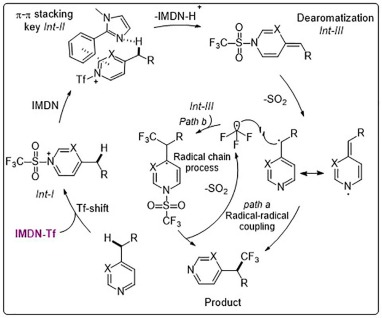
Swaps involving single atoms are uncommon as strong bonds within molecular structures are hard to break selectively. However, Bill Morandi’s team at ETH Zürich in Switzerland has announced a carbon-to-nitrogen exchange in N-alkyl indoles, effectively transforming them into the respective benzimidazoles. This one-step reaction employs straightforward, readily available reagents, eliminating the need for metal catalysts or protective groups.
Morandi’s team is at the forefront of skeletal-editing, altering molecules at the atomic scale to explore new realms of chemical diversity. Their recent findings show that intricate, drug-like compounds can be modified in a single synthetic step, offering potential benefits to the pharmaceutical and agrichemical sectors.
The reaction itself boasts an elegant design. It unfolds through a meticulously coordinated series: oxidative cleavage to the Witkop intermediate, then amide formation and Hofmann-type rearrangement. This sequence relies on commercially accessible reagents, such as ammonium carbamate, which acts as the nitrogen provider, along with phenyliodine(III) diacetate (PIDA). The specificity arises from the selective generation and reactivity of the Witkop intermediate, which directs the transformation while minimizing side reactions.
‘This operationally straightforward reaction setup allows for the creation of complex benzimidazoles in just 30 minutes,’ states Ann-Sophie Paschke, a team member. By substituting a single atom in the indole framework, a prevalent motif in bioactive compounds, the physiochemical attributes of the molecule can be modified, and new target binding sites may be introduced. ‘With our method, naturally occurring indoles from commercial suppliers or established libraries can be directly treated under the reaction conditions,’ Paschke adds.
Contrary to conventional methods for molecular diversification, which often depend on peripheral functionalization, this strategy alters the fundamental framework. No extra functionalization of the parent indole is necessary, permitting the utilization of existing compound libraries. However, single atom exchanges generally require the addition of specific functional groups, such as azides or N-oxides, thus constraining the applicability in late-stage diversification.
The group emphasized this late-stage adaptability by applying the reaction to 15 drug-like indoles, ‘showcasing its potential as a valuable enhancement to the medicinal chemistry arsenal’ of molecular editing. Among these, a 5-HT1C antagonist analogue was converted into a benzimidazole, highlighting the reaction’s compatibility with sensitive functional groups like urea. A phosphatidylinositol-3 kinase inhibitor also experienced the swap to its benzimidazole derivative with minimal impact on the sulfonamide’s function. These instances underscore the method’s versatility and significance for real-world drug frameworks.
Additional research groups have introduced promising methodologies for single-atom exchange reactions, broadening the scope of late-stage editing techniques. For example, in morphine, substituting an oxygen in the core E-ring with carbon resulted in an analogue that preserved pain-relieving properties while diminishing side effects, demonstrating how precise atomic modifications can refine biological function.
Alec Christian, associate principal scientist at Merck, considers this innovative methodology ‘distinctive and enhancing the toolkit’, and states, ‘one of the most significant aspects of this research is the ability to modify the electronic properties of molecules, which can directly affect their biological functionality’. He mentions that, ‘it’s uncommon to find a technique that facilitates a controlled nitrogen addition at a late stage, directly on intricate scaffolds’.
Armido Studer, an organic chemist from the University of Münster, remarks that ‘the elegance of this approach resides in merging well-established reactions into a single step, directly converting indoles into benzimidazoles without the need for pre-functionalization’. ‘Indoles represent a common framework in biologically active compounds,’ he adds, ‘modifying them through single-atom exchanges can swiftly generate analogues for drug development’.